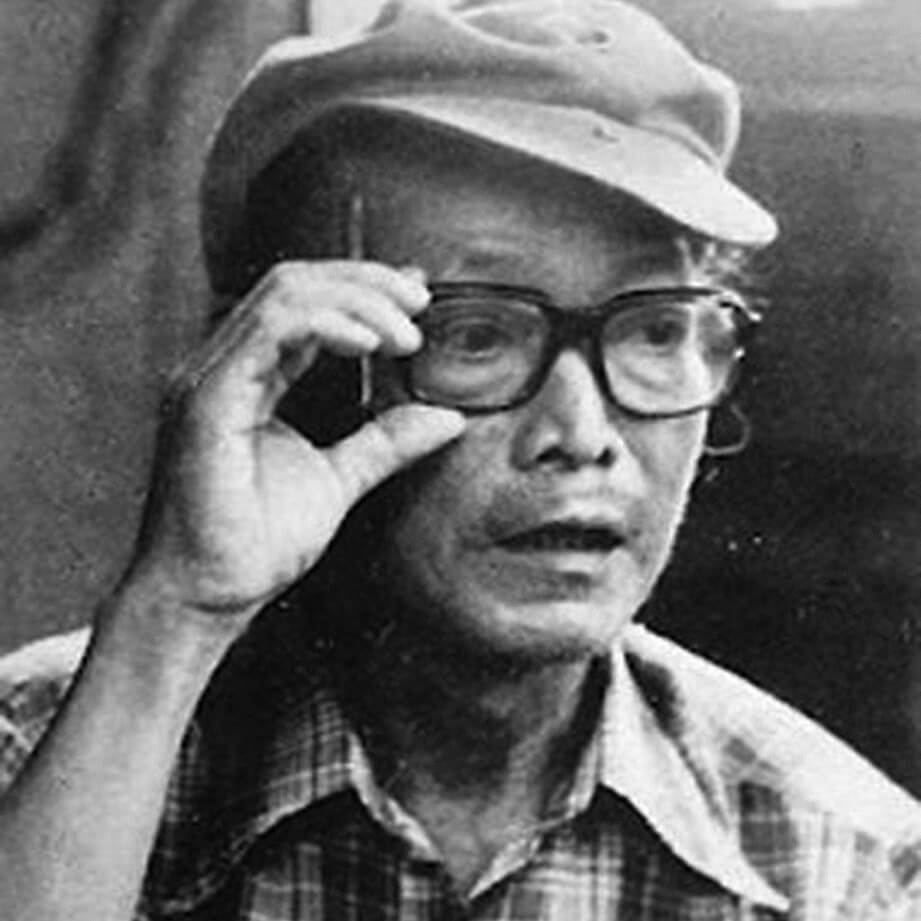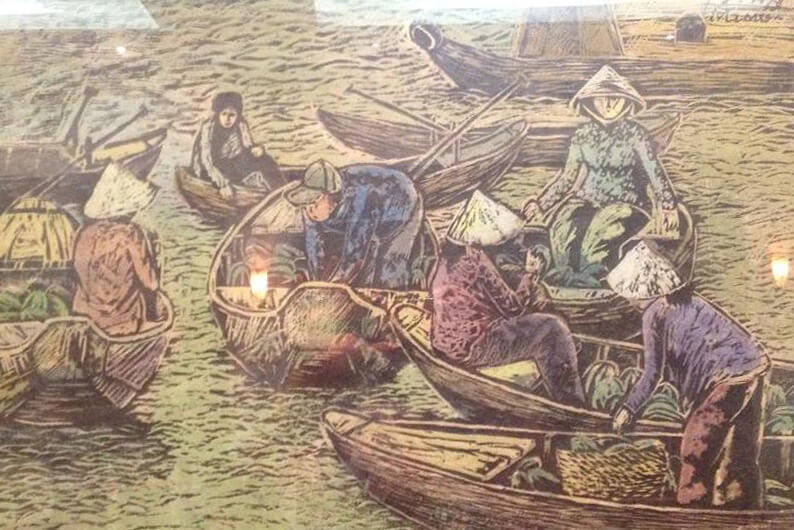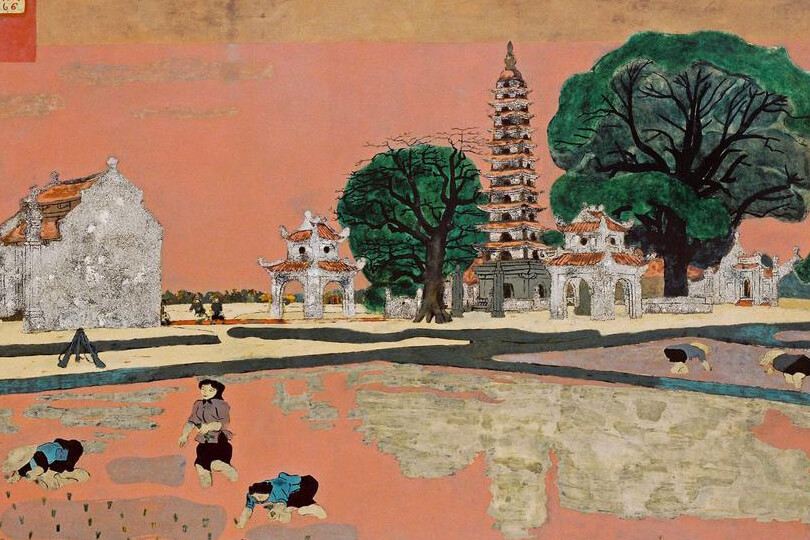Biography of Nguyen Sang
Nguyen Sang, was born 1 August, 1923, in Dieu Hoa village, My Tho province, Viet Nam. He is a Vietnamese painter who has made many typical contributions to Vietnamese modern painting.
He is a thoughtful painter who solves great and dramatic social problems very skillfully, moves with modern, simple pictures and colors. Along with Nguyen Gia Tri, Nguyen Tu Nghiem, he is the “giant tree” of Vietnamese lacquer. The most successful works of Nguyen Sang are in lacquer and it is Nguyen Sang’s greatest contribution to painting both in terms of material and reputation. Moreover, he was considered as the leader of 4 masters “Sang – Nghiem – Lien – Phai” in Vietnamese Contemporary Fine Arts.
He lived and worked at 65 Nguyen Thai Hoc, Dien Bien ward, Ba Dinh district, Hanoi for a long time. He used to study at Gia Dinh Fine Arts School (1936 – 1938) and then he continued studying at the Indochina Fine Arts College class 14 (1941 – 1945). He was a member of Vietnam Fine Arts Association from 1957; Member of the Executive Committee of Vietnam Fine Arts Association, 1st tenure (1957- 1983); artist of composing group of Vietnam Fine Arts Association; First Prize in the national fine arts exhibition in 1954.
Nguyen Sang‘s Career
Nguyen Sang was sympathetic to the ideas and values of the revolution, which he joined in Hanoi in August of 1945. In his autobiography he explained: “The art students of the period were influenced by the revolution—the Indochinese Communist Party—so there was a political tendency to overthrow the exploitative oppression of the French.” His contributions to the revolutionary efforts including drawing propaganda images as well as designing stamps and banknotes. He created the first postage stamp for independent Vietnam, which bore the likeness of Hồ Chí Minh. At the end of December 1946, he used his brushstrokes to serve the resistance war in the Viet Bac War Zone. In 1949, during the period of a resistance war in the mountains of Viet Bac, Sáng was commissioned to created a second set of stamps commemorating Hồ Chí Minh’s 59th birthday.
From 1948-1951, he worked at the Popular Painting Workshop of the Ministry of Information and Communications located in Yen Gia, Dai Tu – Thai Nguyen. From 1951-1952, Nguyen Sang participated in the Cao-Bac-Lang campaign and painted on the Vietnam-China border with painter Nguyen Tu Nghiem. After that, he joined the General Department of Politics to make woodblock prints in color with many topics such as: Cao-Bac-Lang Campaign, Militia’s Love… Many small-sized woodcuts and lacquer paintings by him and Nguyen Tu Nghiem created on this occasion.
After attending the political correction (1952), he participated in land reform and then went to Dien Bien Phu campaign with many other painters such as: To Ngoc Van (1906-1954), Nguyen Si Ngoc (1919-1990) )… Thanks to that, when he returned to Hanoi, he had the subject of many lacquer paintings about soldiers in historical campaigns: Dien Bien Phu, Cao Bac Lang, etc.
In 1953, he was assigned to work in land reclamation and also visited the battlefield in Laos. In 1954, after peace was restored in the north, he became quite productive, creating illustrations and working in varied media including pastel, oil and lacquer. Increasing pressure to paint images that served the ideology of the new Communist government meant that he and other artists were expected to work in the Social Realist style, which he resisted. He was one of the artists involved in the Nhan Van Giai Pham affair of 1956, during which artists proposed “art for art’s sake” rather than the government’s line of “art for the people.”
When American bombers attacked North Vietnam in 1964, Sáng remained in Hanoi painting portraits including his artist friends Bui Xuan, Duong Bich Lien and Nguyen Tran. He also painted and sketched in the mountainous area of Cao Bằng.
Between 1966 and 1974 Sáng made paintings in oil and lacquer depicting characteristically Vietnamese subjects including Pagodas, horses and eagles. While living the Ho Chi Minh City after 1977 he painted portraits, girls and women and also social gatherings, often working with lacquer in large formats. His style varied from realistic to imaginative and stylized. He continued to live and paint in humble circumstances into the 1980s.
In 1984 the Vietnam Fine Arts Association (in cooperation with the Vietnam Fine Arts Museum) organized the first survey exhibition of Sáng’s work in honor of his 60th birthday. It included some 140 works in oil and lacquer as well as wood carvings and pastels.
Nguyen Sang passed away on December 16, 1988, celebrated as an artist who was socially enlightened and proud of his nation’s struggle. In 1996 he was posthumously awarded the Ho Chi Minh prize in Literature and Fine Art.
Nguyen Sang‘s Highlighted Artworks
• Portrait de femme, 1954
• “Chat” (Mèo), 1977
• Wrestle, 1984
• Sumo, 1976
• Portrait of a Young Lady, 1971





